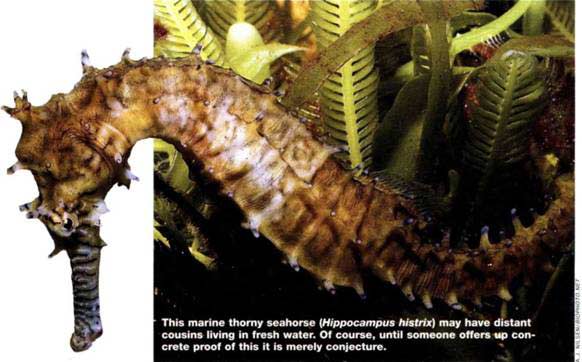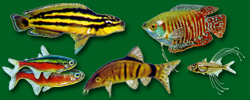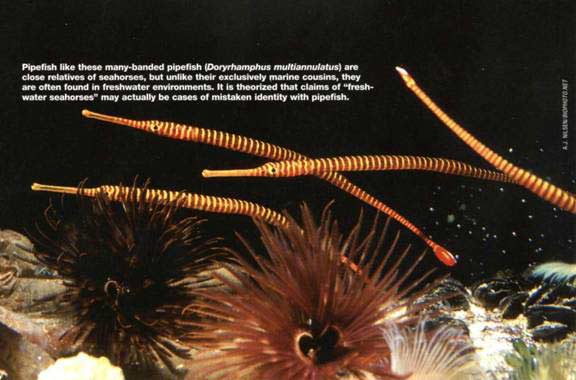Интересная статья о пресноводных "морских коньках", якобы открытых Рабаутом где-то в реке Меконг в 50-х годах и которым, тем не менее, не было суждено попасть в аквариумы любителей. На английском языке.
 |
| Mythical Freshwater Seahorses |
| Did a famous naturalist discover these, or are they a fantasy? |
| By Lovel and Joy Tippit |
 | Lovel Tippit began in the hobby more than 30 years ago. Lovel and Joy once owned a pet shop and fish hatchery, and they have a large antique aquarium book and magazine collection |
 |
Early in 1950, George S. Myers, then of Stanford University, was contacted by one of the hobby's most elusive characters. A date was set for a meeting, and what followed could have changed aquarium history, as we know it. That meeting could have opened up a new door in seahorse culture. Because the man who contacted Myers that day claimed to have found a freshwater seahorse in Asia.
The man was no less bizarre than his claim. His name was August Rabaut. In spite of Rabaut's eccentricities, he was one of the most respected explorers of the natural world during the 1930s. Not only have several flowers and aquarium fish been named after him, but Rabaut was the one who discovered the neon tetra (the neon tetra was described by George S. Myers in 1936 and named after William T. Innes, who originally supplied Myers with the fish for identification).
In my opinion, August Rabaut was one of the most important figures in the aquarium hobby in the 20th century, even though he was a faceless figure who hated the limelight. And in all my years of collecting aquarium literature I have never found a picture of him. Rabaut has both mystified and intrigued me. How can a man live such an extraordinary life filled with such grand accomplishments and never pen a single word of his own?
His Beginning
By the early 1950s, August Rabaut had been in business for himself for sometime. During the early 1940s, Rabaut begin operating a low-cost import business in Brooklyn, New York, with a base in Singapore. His New York branch consisted of several aquariums that remained empty for most of the year until he returned from Asia with fresh stock.
It must be noted that Rabaut was not a hobbyist. In the 1930s, principals at a public aquarium in Hamburg, Germany, summoned him before he set out on a South American orchid-collecting expedition. They were interested in tropical fish and willing to pay for them. In those days sailors collected most new aquatic imports as a means of making extra cash. However, they were generally unable to penetrate deep into wilderness areas during their searches.
A World Traveler
Rabaut was not afraid to go where other explorers had not gone before. He had spent years in Venezuela prospecting for emeralds and hunting alligators for their hides in other parts of South America. He possessed wide experience and, more importantly, a willingness to gamble if his gut told him to, although this quality would ultimately tarnish his reputation. So, Rabaut agreed to look for fish on his expedition to South America. Once in the depths of the jungle, a native told him of a fish with lights. He followed his instinct and discovered the neon tetra, which he brought to Germany. This new fish was unleashed on the American hobby in 1936.
Rabaut saw lucrative opportunities in bringing fish to science. He began partnering with the Paramount Aquarium out of Germany during this time. He and his wife tried repeatedly to bring enough neon tetras to market to become wealthy, but every one of their trips seemed hexed. Soon others were filling their bank accounts by setting up routes to export neon tetras. From that point on Rabaut became fiercely secretive.
Surprise Find or Hoax?
Now we jump ahead again to the early 1950s and the meeting that Rabaut set up with Myers. Rabaut's days with Paramount Aquarium had ceased, and he was now in business for himself. It was understandable that Rabaut would contact Myers with word of his freshwater seahorses. After all, Myers was the scientist that described and named the neon tetra.
They had a history together, or you could say they made history together. Although Rabaut was an amazing explorer, his eccentricities worked against him as a businessman. He was always willing to bet on long shots; the problem was that he was willing to do this with other people's money too.
I've talked to a couple of people from that era who either knew Rabaut personally or at least his reputation. They stated that everyone was aware of his Asian freshwater seahorse story, but that nobody trusted him enough to gamble their money on him.
At the same time they said that only a few were quick to dismiss his story completely. In fact, one man told me, "If there was anyone that could have found a freshwater seahorse in Asia, it was Rabaut." Yet, people had invested in him in the past, and he'd come up short. True to his nature though, after telling Myers about his seahorse discovery Rabaut went mute on any other details except that the specimens were collected in a freshwater stream somewhere in Asia.
In fact, Meyers later wrote that it was Rabaut who was full of questions. He wanted to know if there were any records of freshwater seahorses. He did not even have the fish's dead remains, but he still wanted $10,000 to fund an expedition in the name of science. Myers didn't think the sum was unreasonable, and deep down I think he believed Rabaut, but his institution simply didn't have funds for such an excursion.
Was Rabaut's Asian freshwater seahorse real or an elaborate hoax? There are some who produce very convincing arguments in favor of the idea. Ross Socolof, himself an aquarium legend, is one such believer.
Socolof knew Rabaut briefly in the 1950s before Rabaut retired. Socolof would later write: "Rabaut had been working with a fine-meshed net swishing [it] through some fine-leaved aquatic plants trying to get live food for his hungry fish. He was then waiting for a small plane to pick him up. He did not catch much live food but did catch small (baby?) freshwater seahorses. I have collected many marine seahorses, and I knew from his description of the collecting area that it was just where juvenile seahorses would be found.
"I thought about this story many times, especially in future years when some new fish appeared that no one anticipated. I always (almost) believed his story. And I never could convince myself that he could have invented this phantom fish. This was the man who had discovered the neon tetra, and if his story was made up, I would have to know why. He was in business for another three or four years, and why he never went back to try again remains an unanswered question."
Further Evidence
Although Rabaut contacted everyone from Innes on down for the needed funds to make the exploration in search of the freshwater seahorses, I was careful to focus on his meeting with Myers. Myers was like Socolof in that he always almost believed in the story. Some 25 years later he came across something that further convinced him. In 1979, Myers published a two-page report via the California Academy of Science.
In it he wrote: "In November 1977, I stumbled on a confirmation of Rabaut's story of a seahorse in fresh water. I was looking up some references concerning other literature in the zoological record when my eye alighted on the citation of a paper published in 1916 by the Paris Museum of Natural History.
It described a hitherto unknown species of freshwater seahorse, (named) Hippocampus aimei (Roule), from the Mekong River. Aime collected two specimens in 1910. They had been caught close to the rapids of Kenmarat, in that part of the river that forms the boundary between Thailand and Laos. One was a male and the other a female."
Today, H. aimei is considered to be a misapplied synonym for H. barbouri that is found in Indonesia, Malaysia and the Philippines saltwater corals. Considering that seahorses are related to pipefish, which often are found in fresh water, Rabaut's story moves into the furthest reaches of possibility.
However, I don't think the fish Rabaut or Aime found (if they found them) were H. barbouri because the Mekong River doesn't pass through where H. barbouri are known to exist. The Mekong does connect with Thailand, Cambodia and Vietnam, or what was once French Indochina.
This is relevant in that Rabaut would not disclose the exact location of his discovery, but he was French and spoke the language. Remember, his home office was in Singapore, which is at the tip of the Malay Peninsula. If you flew across the Gulf of Thailand to what was then French Indochina, it would be a short flight.
And what was Rabaut waiting for when he dipped his net into the water? That's right — an airplane. So is there such a thing as an Asian freshwater seahorse? I have no idea! Remember that within history's archives there is a line drawn, and it is there that we will meet again when "Timeline" investigates.







